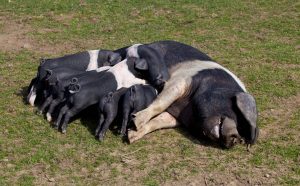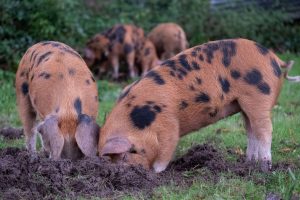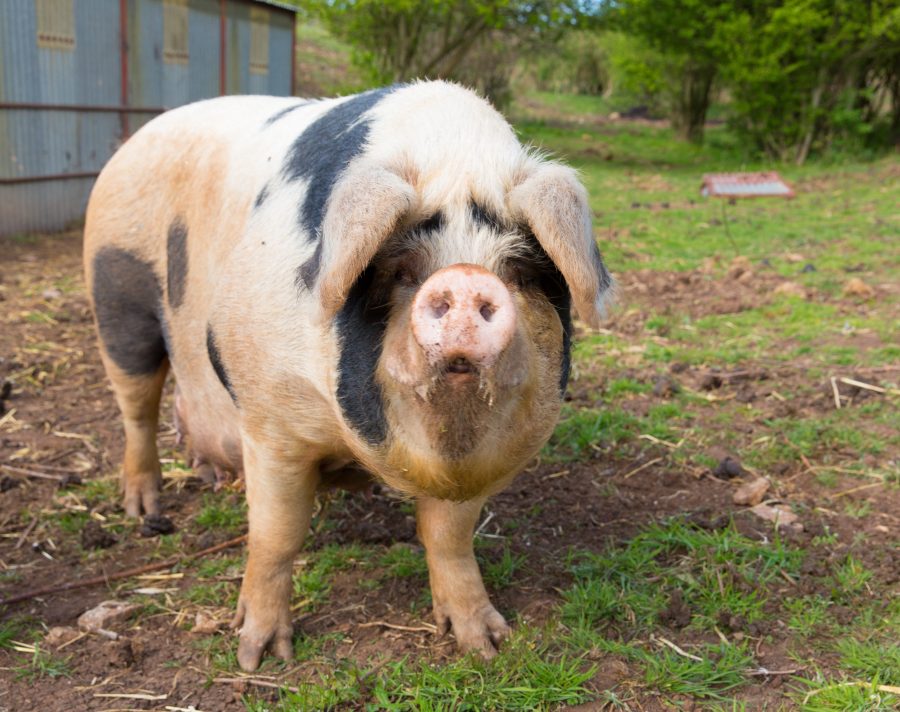Joanna Palmer, nutritionist for Smallholder Range offers her top tips for feeding a variety of pigs and piglets…
It is important to carefully consider the type of feed you choose for your pigs based on their breed and the production system in which they are kept. The rare and traditional breeds of pig favoured by most smallholders and small-scale farmers take much longer to mature than hybrid animals and can very quickly become overweight on high-protein commercial feeds. More suitable feeds for our traditional breeds will tend to be lower in protein and energy but higher in fibre than commercial feeds. This helps to promote slower, more natural growth rates, with the emphasis placed firmly on the longevity of the breeding animal and the quality and flavour of the meat produced from their offspring.
Feeding piglets
While their mothers’ milk will provide all the essential nutrition piglets need in their first weeks of life, a pig starter pellet can be fed from around two weeks of age onwards. The introduction of a feed at this age helps to promote gut and digestive enzyme function, so that by the time the piglets are weaned their digestive systems are capable of efficient digestion of food other than milk Starting off with just a handful of pellets is an ideal introduction to solid food which can be fed dampened initially so that it forms a mash type consistency and is easily ingested. The amount fed should be gradually increased so that by the time piglets are 5-6 weeks of age, they are gaining the majority of their nutrition from the pelleted feed. Having piglets happily established on a solid feed before they are weaned from their mothers means that they are less likely to suffer digestive upset or growth setbacks once milk is no longer available.

Feeding weaners
At weaning, piglets can be fed starter pellets on a free access basis before being changed on to a weaner/ finisher pencil at any time between 7 and 14 weeks of age. The starter pellets and weaner pencils should be mixed together for a period of 7 to 10 days; as the proportion of weaner pellets is increased the starter pellets can be decreased. This encourages a smooth changeover and helps avoid any sudden changes in the diet that could cause digestive upset. Ad lib feeding can continue until approximately 15 weeks of age, when it then becomes necessary to restrict feed intakes by moving to a routine of feeding twice a day. Depending on breed, age, size and condition, weaners should be fed between 1.5kg and 2.5kg of weaner pencils per day, split over their two meals. Weaner pencils should continue to be fed until the pigs reach the desired slaughtered weight or are ready to move on to an adult maintenance diet.
Feeding breeding sows & boars
A sow breeder pencil is an ideal feed for maintenance, pregnancy and lactation. The nutritional requirements of sows can be met at every stage simply by varying the quantity of feed that is fed. Flushing sows and gilts for three weeks before mating by feeding their breeder feed on an ad lib basis can help increase ovulation rate and litter size. Once mated, the feed level should be reduced to around 2kg per animal per day for the first month of pregnancy as overfeeding at this stage can reduce litter size. Thereafter feed rates should be adjusted so that sows reach farrowing at an ideal body condition score. Depending on their breed and size, between 1.5 and 2.5kg of a sow breeder feed per day is usually appropriate for most sows during the first three months of their pregnancy. It is only during the final three weeks of gestation when the majority of the piglets’ growth and development of the udder occurs that feed intake should be increased. Boars tend to need very little extra feed above a maintenance ration of 1.5-2.5kg/day of breeder feed unless they are mating with a large number of sows in a short space of time, in which case their activity levels will increase and they will require more feed. During lactation the amount of feed a sow requires will depend on the number of piglets she is suckling. A sow’s milk production peaks at three weeks post farrowing and places considerable extra nutritional demands on the sow. Although the amount and composition of milk will vary through the length of lactation, a good quality breeder diet will provide the necessary nutrition to support milk quantity as well as quality. Feed amounts should be increased gradually from farrowing to 3-3.5kg per sow per day. If the sow is suckling more than six piglets she will then require an additional 0.5kg per day for each extra piglet or be fed ad lib. A sow’s feed requirements may exceed her appetite which can affect milk yield and cause a loss of body weight. Although some weight loss can be expected during lactation, it is important that sows do not lose too much weight as this can have a detrimental effect on subsequent conception rates and litter sizes.
Feeding pet pigs
Generally speaking, all small breeds of pigs, including Pot-Bellied and Kune Kune thrive on a high fibre diet that in the wild would consist mainly of grass, nuts, berries, insects, fruits and vegetables. These types of pigs and any that are kept as pets, regardless of their breeding, have a tendency to gain weight very easily. Obesity can be a serious problem, causing long term health implications as well as foot and joint problems from excessive weight-bearing. Keeping your pigs at healthy body weights by avoiding the temptation to overfeed them is key to keeping them happy and healthy. A pet pig feed that is specifically formulated to be higher in fibre, with lower calorie and protein levels should be fed. This will help to reduce the risk of obesity in all types of pigs that do not require a specific rearing or breeding feed, but still provide a nutritionally balanced diet. Body condition scoring is a useful tool to help you assess whether your pigs are too fat. At a healthy weight and condition, a pig will have a spine that can be felt when you run your hand firmly along its back. A spine that can be seen or felt very easily with a light touch indicates that the pig is thin, whereas a pig with a spine that cannot be felt even with firm pressure is likely to be overweight or obese.
Do NOT feed kitchen scraps
Supplementing your pigs’ bagged feed with fruits and vegetables will add variety to their diet. It is however important to remember that to prevent the introduction and spread of potentially devastating notifiable animal diseases, such as Foot & Mouth, it is illegal to feed catering waste, kitchen scraps, meat or meat products to farmed animals. This also means that any fruit and vegetables you intend to feed your pigs cannot enter your kitchen or be purchased form an establishment that also sells meat, and you most certainly cannot feed your pigs any leftovers from the family dinner table!

Encourage foraging behaviour
Providing pigs with as much outside space as possible not only allows them to fulfil their natural foraging behaviour but also helps to increase their activity level, which burns calories and helps to keep body weights in check. Exercise also promotes the development of lean muscle. As a maintenance diet, an adult pig will need to eat between 1 and 2% of its body weight per day in total feed, so any extras such as fruit and vegetables should be included in this daily feed allowance. The feed should be split into several smaller meals and fed at intervals throughout the day. Placing feed in several different places in the pigs’ enclosure and even hiding some will encourage their foraging instincts and help to alleviate boredom by extending feeding time. Ensuring adequate trough space or spreading feed out across a large area will help to reduce competition at feeding times. Fibre in the form of grass and/or straw should be available to provide gut fill and prevent constipation. A constant supply of clean, fresh water is also essential.
For more information on feeding your pigs contact the friendly Smallholder Range Advice Line on 01362 822 902 or visit smallholderfeed.co.uk
More content like this can be found in The Country Smallholder magazine. Subscribe here.
For FREE updates from the world of smallholding, sign up for The Country Smallholder newsletter here.








